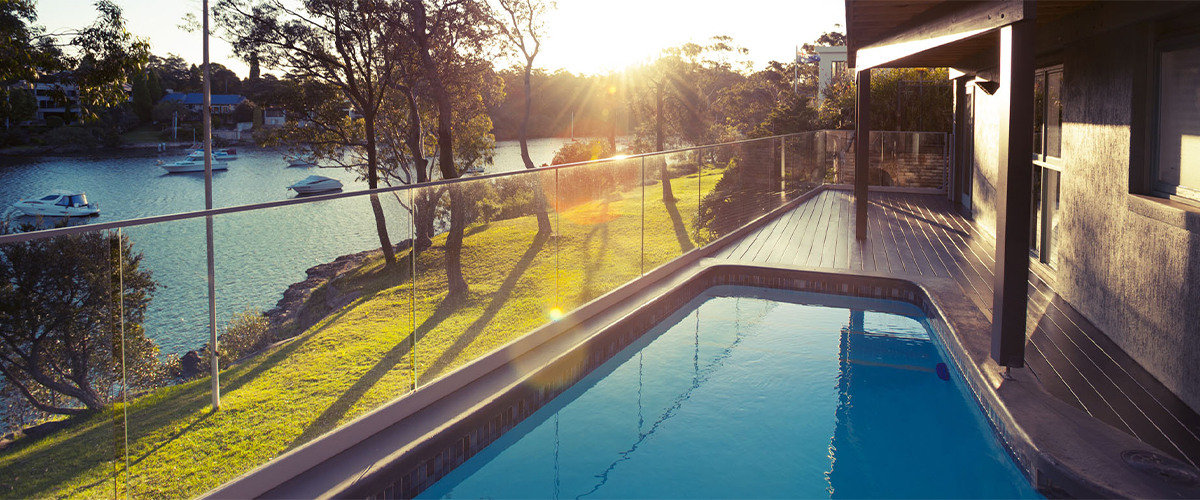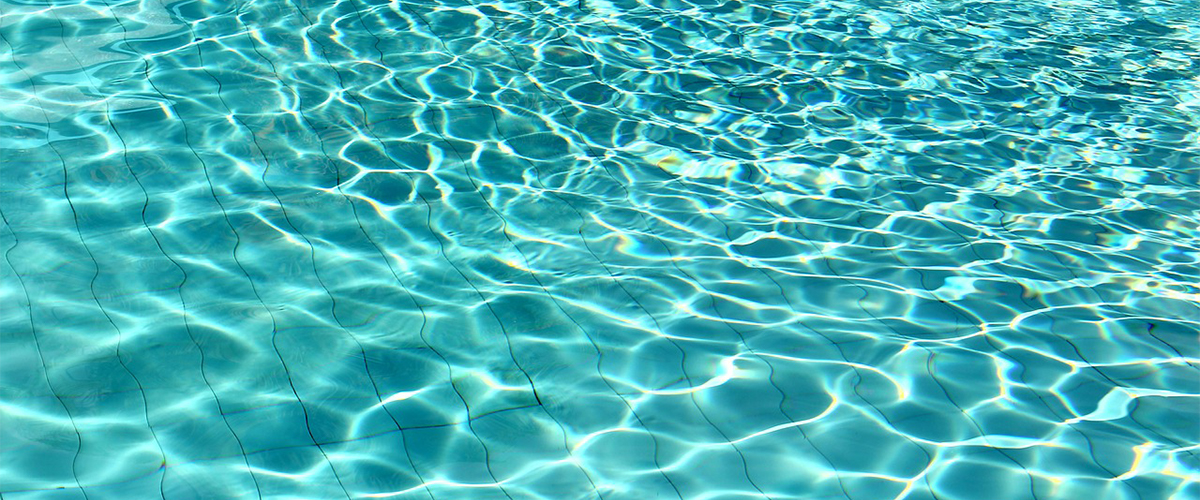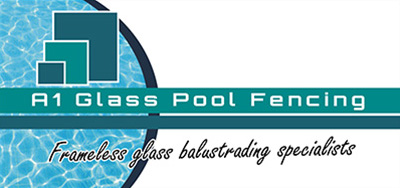
First let’s clarify: What is the difference between a salt water pool and a “normal” pool?
When you hear the term “salt water” relating to swimming pools, you might think of the ocean and sea water. You may even assume that a salt water pool does not contain chlorine at all. This is certainly not the case. The key difference between a salt water and traditional chlorine pool is in how the chlorine is added to the water. In a traditional chlorine pool, chlorine is added directly to the pool water in a concentrated form, whereas in salt water pools, the chlorine is produced by the electrolysis of salt (sodium chloride).
Salt water pools (or more specifically, the systems required to run them) are generally more expensive to purchase than chlorine pools, but tend to be cheaper and easier to run and maintain in the long term. That said, they are definitely not maintenance-free.
While most aspects of swimming pool maintenance will be the same for both types of pools, others will vary because of the differing chemical processes involved.
Swimming pool maintenance can be broadly broken down into 3 categories:
- Manual cleaning/vaccuming
- Pool water filtration
- Balancing chemical levels
Although this guide provides an excellent overview of the maintenance of salt water pools, it should not replace the instruction manuals for your pool pump and other accessories. If you’re really stuck, your local pool shop will usually be happy to assist, or at least to point you in the right direction.
A Well Maintained Pool Is Cheaper To Own In the Long Run
The most obvious maintenance aspect of any swimming pool is cleaning. Regular cleaning is essential to avoid excess build up of debris, which in turn makes cleaning more difficult. You should also regularly rinse and clean any equipment used to clean your pool, in order to prolong its usable life as much as possible.
Filtration: Run The Pool Filter Pump Every Day
The pool filter should be run every day, for at least a couple of hours, depending on the size of the pool and the capacity of the pump, and even if the pool is not being used. Every pool is different, but the following can be used as a rough guide for determining the length of time you should be running your pool pump throughout the year. Most modern pool pumps will include a timer setting, which can be easily adjusted.
|
Season/Use |
Recommended Filtration Per Day |
|
Very low use/no use |
2 hours |
|
Moderate/occassional use |
4 hours |
|
Daily/heavy use |
8 hours |
Other Cleaning and Essential Maintenance
Apart from filtration, the pool water should also be cleaned of debris at least a couple of times a week. The simplest method of cleaning is simply using a standard “leaf scoop” on a long pole to remove all visible and floating debris. If left unattended, floating debris will eventually rot and sink to the bottom of the pool.
Pool Vacuuming – Manual or Automatic?
The cheapest pool vacuuming implement is a suction or hand vacuum cleaner, which connects to the pool filter via a thick hose, and (controlled by a long rod which you hold) sucks up the debris as you manually push it around the bottom of the pool. Depending on the size of your backyard pool, it may take between one and two hours to thoroughly vacuum the entire pool.
Automatic systems are a lot more expensive but have the advantage of saving you time, compared to vacuuming the pool manually. Mechanical vacuum cleaners are often known as “Kreepy Kraulys” (after a popular brand of cleaner). These are the cheapest types of automatic cleaners. They shuffle themselves along the bottom and up the sides of the pool, vacuuming up dirt and debris as they go. Be aware that, just as with a household vacuum cleaner, there are limitations to what these little crawlers can pick up. Objects such as larger sticks or kids toys which you would easily spot (and hence avoid) during a manual vacuum, will quickly get stuck, blocking the intake and greatly reducing the effectiveness of your automatic pool vac.
.. or you can hire a Professional
Of course there’s also a third option – pay a pool cleaning contractor to do the job for you. This is a good option for pool owners who simply don’t want to spend a single minute maintaining their pool. Get a couple of quotes (again, your local pool shop can be a good place to start) and compare the cost over a year, with an automated solution which will require minimum effort on your part. You might be pleasantly surprised to discover that an automated system can cost less than one years servicing by a professional. Do the math, and make a decision which meets your family’s needs and budget.
Tip: A pool cover or pool “blanket” can be a great way to reduce swimming pool maintenance time and costs, especially if your pool is surrounded by messy leaf-dropping trees. Pool covers will reduce water evaporation (which helps keep the concentration of chemicals stable) and can also help keep the water temperature a couple of degrees warmer during the colder months of the year.
Cleaning Filter and Other Essential Pool Maintenance Equipment
Regularly inspect and clean the pool filter basket, pump and skimmer. Check to ensure they are working properly and clean off any dirt or other debris with a hose or under running water. This should also be done once a week, or after any large storm or or other event (e.g. a pool party!) which could be the cause of more debris ending up in the pool.
Cleaning the Salt Water Chlorine Generator Cell
The salt water chlorine generator also requires cleaning and maintenance, as salt crystals tend to build up on it over time, causing it to clog up and not work properly. Follow the manufacturer’s instructions for how frequently to do this. Some manufactures recommend doing it every 3 months, whereas others may state that once per year is sufficient. The salt build up on the generator cell can be washed off with a high pressure hose, and it’s also fine to gently scrape off any excess with a wooden or plastic tool. If the build-up is very hard to get off, or for a very thorough clean, soak the cell in an acid solution and then rinse it off with water.
Why Are Pool Chemical Levels Important?
Swimming pool water must also be kept free of bacteria and other microbes and contaminants that are a health hazard to humans. This is done by chlorine, which in salt water pools is generated by the electrolysis of salt, as mentioned earlier. Although this method tends to keep chlorine levels more stable than a traditional chlorine pool, the level of chlorine still needs to be checked.
Other things that need to be tested are pH, total alkalinity, salt and calcium. Your local pool shop will be happy to test and analyse your pool water sample, and sell you whatever chemicals you need to bring everything back into balance again. Many pool owners prefer to test the water themselves at home using disposable strips or a drop kit. These kits are inexpensive and can be bought from a pool supplies shop, your local hardware store, or online.
Salt Water Pool Chemicals: The Technical Stuff

How often should a pool be chemically tested?
Chlorine and pH should be tested at least once a week, and more often if the pool is used frequently, or in very hot weather. Free chlorine levels should be between 1 and 3 ppm (parts per million). This can be adjusted using the controls on the salt water chlorine generator – refer to the instruction manual for more details. Sunscreen, swimwear, sunshine and rain – all these and more effectively “kill” chlorine levels in any swimming pool, hence the need for regular topping up of salt.
Tip: Chlorine levels can also be increased quickly by way of a chlorine “shock” – we cover a bit more on that a bit further on in this article.
pH refers to the acidity or alkalinity of the water, with neutral being 7.0, acidic being less than 7 and alkaline greater than 7. pH is affected by rain, people swimming in the water, and other factors. The recommended pH of pool water is 7.0-7.8. A pH outside of this range can cause health problems such as itchy skin and red eyes. It can also reduce the effectiveness of chlorine. If pH is too high, you can lower it by adding pool acid. If it is too low, it can be increased using sodium bicarbonate or similar products. Again, check your pool instruction manual for specific levels and amounts to add.
Total Alkalinity, Salt and Calcium
Alkalinity, Salt and Calcium levels should in most case be tested at least once a month.
Total alkalinity (TA) refers to the amount of alkaline chemicals in the water. TA levels should be 60 to 200 ppm. If TA is too low, the pH of the water will be unstable – that is, it will change easily. Over time, a low TA may also cause damage to the concrete surfaces and paint in the pool, as well as corrosion of pool equipment. If TA is too low, you can increase it by adding sodium bicarbonate, and if it is too high, you can add pool acid. As TA and pH are connected, changing one level may affect the other, so it is important to re-check both TA and pH if you have added either of these products to the water.
Salt is used by the salt water chlorine generator to generate chlorine, and salt levels will decrease over time. Recommended salt levels vary by manufacturer, but are generally in the range of 2700-4500 ppm. If the salt level is too low, simply add a few bags of pool salt to the water.
Calcium hardness in a salt water pool refers to the amount of calcium dissolved in the pool water. If calcium levels are too low, the pool surfaces and equipment will gradually degrade. However, high levels of calcium will cause the build-up of scale or “scum” on surfaces over time. Calcium can be manually added to the pool if the levels are too low. If the levels are too high, you can drain some of the water and replace with fresh water. This will lower the concentration of calcium in the water by dilution, but will of course affect other chemical levels also.
Shocking A Swimming Pool With Liquid Chlorine
“Shocking” a swimming pool refers to adding a large amount of chlorine to the water to greatly increase the level of free chlorine for a short time, thereby destroying contaminants such as bacteria. There are differing opinions on whether shocking is needed for salt water pools. However, it can be useful to do once a year for a thorough clean, or to prevent the water from becoming cloudy before or after many people using the pool.
When shocking the pool, there are a few important points to note. It should be done when all the other chemical levels are correct – it’s usually best to wait around an hour after adding the last of any other chemicals to the water. The pool filter should be run for 6-8 hours before shocking. Shocking should be done after sunset, as ultra-violet (UV) light from the sun will reduce the levels of free chlorine. This means that if you perform the shocking in daytime, you will need to more chlorine to have the same effect.
It is important to purchase chlorine that is appropriate to use in salt water pools, and to use the correct amount for your size pool. After adding liquid chlorine, run filter pump for a minimum of 6-8 hours. Make sure no-one swims in the water during this period as the chlorine levels will be very high.
After 8 hours or more, re-test the water’s level of chlorine. Although the recommended level is 1-3 ppm, it is considered safe to swim in pool water when the level has fallen below 5 ppm.
Safe Handling of Swimming Pool Chemicals
Great care must be taken when handling pool chemicals. Always read the label on the bottle or container, and follow manufacturers’ guideline regarding storage, as well as the use of personal protective equipment. Ensure that pool chemicals are stored high and dry, in a well ventilated area, away from other chemicals, and well out of reach of inquisitive children. This is intended to be a general guide only.

Comments 0
Your comment is awaiting moderation.
Since the start of the digital ripen, millions of users secure мейд a trade to Blockchain that is claimed to switch the style we disperse in support of goods and administer transactions. No be inquisitive it is a game-changing technology that makes a difference and brings settled privacy. But what you might not differentiate is that Blockchain records all transactions in its publicly on tap ledger, meaning that third parties can evidence them should the emergency arise. If it’s not that straightforward of confidentiality you’ve expected, be sure to accept more favourably of our create mixer.
CryptoMixer is a Bitcoin mixing service (also known as a tumbler or blender) that is centered here the idea of making your digital assets arcane from the civic partiality recompense good. As the rating implies, it works during mixing your coins with those in our cryptocurrency reserves to confirm concealed transactions without a trace. CryptoMixer helps you mould your BTCs unidentifiable and, wise, allows you to idleness effortlessly knowing that neither crypto-hackers nor asylum agencies can care for path of your monetary activities.
Why our Bitcoin tumbler stands far-off from the rest
What forms the caryatid of CryptoMixer is that it has been designed with the needs of Bitcoin community members in mind. It is your privacy and security that underpin our mixing servicing and inspire us to reject all decentralized opportunities to your advantage. That is why we’ve done our utmost to incorporate the following features into our Bitcoin blender:
The highest on the up of screen
Our servers turn to account http://oldtradergold.blogspot.com/2013/06/blog-post_27.html advanced encryption methods to ensure the honour of all information stored and minimize the jeopardy of the Blockchain analysis. What is more, we provender every buyer with a together code to prevent mixing their coins with the ones they’ve sent to us before. Besides from that, we regularly obliterate all details of your transactions, including arriving Bitcoin addresses.
Redoubtable mixing capabilities
Whether you’re looking to mix 0.001 BTC or several hundreds of coins, you won’t catch sight of a more commodious use than our Bitcoin tumbler. CryptoMixer has concluded 2000 BTC in its cryptocurrency reserves, which allows you to stock market burly amounts of BTC without waiting seeking other users to send their coins on mixing.
Shoddy fees and the Missive of Guarantee
While other Bitcoin mixing services charge 1% and more with a view http://karyapari.blogspot.com/2013/07/blog-lengkap-mudah-gratis.html each records, CryptoMixer helps you sidestep overspending. Our fees start alone at 0.5% + 0.0005 BTC and can be customized to reap it unrealizable benefit of third parties to glimpse the joint between addresses к4е566